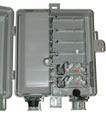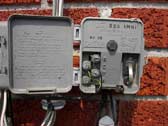Distribute the VoIP
Many people have switched to VoIP for all of their home's phone connections and now want to distribute VoIP throughout the house. This can be done, but only after disconnecting the wires that connect your premises phone wiring from the wires coming from the street or your previous telecom. It is very important to completely disconnect these wires, as from time to time voltage could be introduced into your home, which could damage the VoIP equipment and have other serious effects. If for any reason you are not 100% sure of how to do any of the necessary steps correctly, we strongly suggest that you hire a competent telecom professional.
-
IMPORTANT: This information should only be used as a general reference, as each individual situation could vary from the description presented here. All information is only offered, with prior notice, that No Warranty, expressed or implied, as to the accuracy, validity or correctness of any of the information contained here. And should only be used at your own risk.
How can I connect all of my phones to VoIP?
VoIP installations can include distributing the VoIP phone connection throughout the house. This will make VoIP for the premises use much more suitable, rather than using only one or two phones or cordless phones. The basic steps to connect the house phone wiring to the VoIP would be:
- Discontinue your current service with your present telecom.
- Disconnect the previous telecom's wires from connecting with the home's wires at the Network Interface Box or Demarc (short for demarcation).
- Connect the VoIP RJ-11 cable from the phone jack of the ATA to a wall jack in the house.

Find the rightATA at the leading VoIP Store. VoIP Supply, everything you need for VoIP, since 2002.
The first step in disconnecting from your previous telecom company would be to locate the telephone junction box or demarc (you may see it also spelled demark). This box should be located on the side of the house, usually close to the cable TV box and power.
 Typical
demarc or NIB photos
Typical
demarc or NIB photos
This is the box where the telecom's wires come from the street and connect with the wires from the house. Many demarc boxes have two sections, one where you have access to the premises' section (customer access) and the other where the telecom company has access. Once you open the box, you will see telephone wires, as well as a ground wire. The ground wire should remain connected to a proper grounding source.
Next you will want to identify and disconnect each of the telephone company's lines from connecting with the house lines. This is done to prevent any voltage from entering the premises, which will interfere with the VoIP service and will possible damage the equipment. (This should only be done if you no longer have any active numbers or DSL lines with the local telecom.) In some cases you will need to disconnect the telecom's wires from terminating blocks, (make sure to keep the house wires connected). In some cases you may see a RJ-11 connecter used to connect the house wires with the streets wires. In this case, unplug the RJ-11 connector.



Wrap each disconnected wire with electrical tape as a safety measure.
 After securing the disconnected lines with electrical tape,
you will want to attach a warning note, that the in-home wiring is now in use
for a private network and should not be reconnected. (It is also recommended, that
at this point, you should check with a meter for any voltage that may be
present across the terminals for the in-home wiring. *There should be no
voltage.)
After securing the disconnected lines with electrical tape,
you will want to attach a warning note, that the in-home wiring is now in use
for a private network and should not be reconnected. (It is also recommended, that
at this point, you should check with a meter for any voltage that may be
present across the terminals for the in-home wiring. *There should be no
voltage.)
Then close the box securely.

Points to consider.
When connecting VoIP to the premises' phone wiring you will want to consider some of the following:
- Is there a phone wall plug close to the proximity of the VoIP ATA?
If not, you will need to have a phone line and wall plug installed. The other alternative would be to use cordless phones. Using a cordless phone system will allow you to distribute the VoIP phone connection to other locations without the need to integrate with any of the premises' wiring.
- Do you have more than one current phone line?
If so, you could have several phone circuits in the premises. You will need to connect to the correct phone circuit in order to have the VoIP distribute correctly.
- You want to have a phone by the ATA along with distributing it throughout the premises?

![]() This can be best accomplished by using a two-way phone splitter. Put it
into the ATA's phone port and connect one side to a phone and the other side to
a phone wall jack.
This can be best accomplished by using a two-way phone splitter. Put it
into the ATA's phone port and connect one side to a phone and the other side to
a phone wall jack.
- How many phones will the typical VoIP service ring?
The usual number would be 5 or 6, or perhaps even up to 8 phones, but that will depend on the actual voltage supplied by the VoIP IAD and how much each phone's ringer requires. If you find that after connecting all the phones to the VoIP service, you fail to have all the phones ring or that they ring very weakly, then disconnect the phones. Start with one phone and gradually test the ring until you find either the "problem phone" or exceed the maximum.



